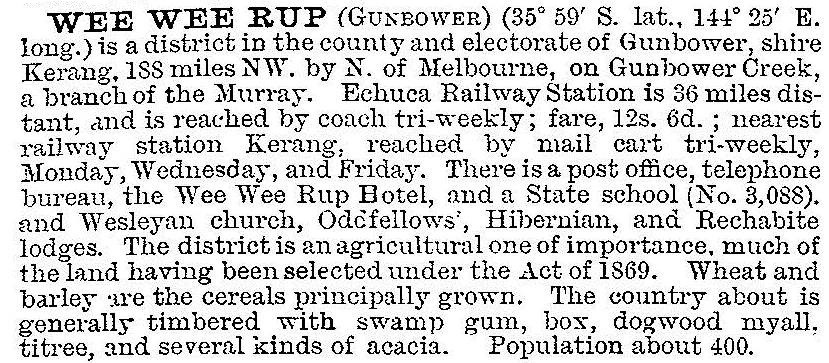Gunbower
Gunbower is a rural township in northern Victoria, 201 km north of Melbourne and 40 km north-west of Echuca. It is situated on the Murray Valley Highway and adjoins an intensively meandered Murray River area to its north. The area includes the Gunbower Forest, containing mainly state forest (195 sq km) but also some private land.
In 1845 the Gunbower pastoral station was first occupied, about 25 km east of Kerang, in the vicinity of the Gunbower and Mount Hope Creeks. It is thought that the name Gunbower is derived from an Aboriginal word meaning twisting, possibly a reference to a creek or river meander.
In 1879 the town of Gunbower was gazetted, five years after the first primary school was opened in the district (Gunbower Creek) and two years after the present primary school was opened. In 1881 the Gunbower Racing Club was formed, nearly opposite the hotel, and the racecourse was later moved to Fox Island (part of Gunbower Island), in the early 1900s. The annual Gunbower races continue as a popular galloping and trotting fixture. Gunbower (also called Wee Wee Rup) was described in the 1903 Australian handbook:

The Gunbower Forest is on Gunbower Island, bordered by the Murray River and Gunbower Creek. The island provided red gum for timber cutting, sandy loams for citrus and market gardens and land for tobacco growing, dairying and grazing. Between 1885 and 1948 there were three schools at various times on the island, and a fourth, Gunbower Sawmill School, ran from 1884 to 1890.
The Gunbower district benefitted from the construction of the Kow Swamp reservoir, the Waranga scheme and the Torrumbarry weir on the Murray River (1923), all for irrigation. The weir is at the eastern end of the Gunbower Island, and Kow Swamp is about 10 km west of Gunbower. The use of river waters, however, has lessened the flood frequency of the forest, and red gum growth has fallen. The forest was artifically flooded in 2014 to mimic natural floods in a move to keep the red gums alive.
Gunbower has an abattoir, a caravan park, a public reserve and oval, three churches, a school with 39 pupils (2014), a hall and a hotel. The area is a venue for fishing and watersports, and there are facilities for tennis, swimming and bowling.
Recreational facilities have overtaken agricultural infrastructure: the butter factory closed in 1959 and the railway line from Elmore to Cohuna (1915) was closed in 1981.
Gunbower’s census populations have been:
| census date | population |
|---|---|
| 1901 | 57 |
| 1911 | 570 |
| 1961 | 902 |
| 1996 | 260 |
| 2006 | 269 |
| 2011 | 264 |
At the 2011 census, dairying accounted for 11.3% of employment and other farming accounted for another 6.6%. In Gunbower and district the population was 522 and dairying accounted for 24.9% of employment (2011 census).
Further Reading
B.P. Atkins and L.N. Lloyd, An interim water management strategy for Gunbower Forest, Department of Conservation and Natural Resources, 1993


